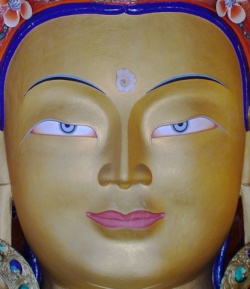Ten Worlds
- See also :
- See also :
Ten Worlds
十界 (Jpn jikkai )
Ten distinct realms or categories of beings referred to in Buddhist scriptures. From the lowest to the highest, the realms of
(1) hell,
(2) hungry spirits,
(3) animals,
(4) asuras,
(5) human beings,
(6) heavenly beings,
(7) voice-hearers,
(8) cause-awakened ones,
(9) bodhisattvas, and (
10) Buddhas.
The Ten Worlds were viewed originally as distinct physical locations, each with its own particular inhabitants. The Lotus Sutra, however, teaches that each of the Ten Worlds contains all ten within it, making it possible to interpret them as potential states of life inherent in each individual being. In other words, from the standpoint of the Lotus Sutra, the Ten Worlds indicates ten potential states or conditions that a person can manifest or experience. The mutual possession of the Ten Worlds is a component principle of three thousand realms in a single moment of life, which T'ient'ai (538-597) set forth in Great Concentration and Insight.
The Ten Worlds may be described as follows: (1) The world of hell. Nichiren's 1273 treatise The Object of Devotion for Observing the Mind states, "Rage is the world of hell" (358). Hell indicates a condition in which living itself is misery and suffering, and in which, devoid of all freedom, one's anger and rage become a source of further self-destruction.
(2) The world of hungry spirits. Also called the world of hunger. A condition governed by endless desire for such things as food, profit, pleasure, power, recognition, or fame, in which one is never truly satisfied. The above work reads, "Greed is the world of hungry spirits" (358). (3) The world of animals. Also called the world of animality. It is a condition driven by instinct and lacking in reason, morality, or wisdom with which to control oneself. In this condition, one is ruled by the "law of the jungle," standing in fear of the strong, but despising and preying upon those weaker than oneself. The same work states, "Foolishness is the world of animals" (358). The worlds of hell, hungry spirits, and animals are collectively known as the three evil paths. (4) The world of asuras. Also called the world of animosity or the world of anger. In Indian mythology, asuras are arrogant and belligerent demons.
This condition is called the world of animosity because it is characterized by persistent, though not necessarily overt, aggressiveness. The Object of Devotion for Observing the Mind states, "Perversity is the world of asuras " (358). It is a condition dominated by ego, in which excessive pride prevents one from revealing one's true self or seeing others as they really are. Compelled by the need to be superior to others or surpass them at any cost, one may feign politeness and even flatter others while inwardly despising them.
The worlds of hell, hungry spirits, animals, and asuras are collectively called the four evil paths. (5) The world of human beings. Also called the world of humanity.
The same work reads, "Calmness is the world of human beings" (358). In this state, one tries to control one's desires and impulses with reason and act in harmony with one's surroundings and other people, while also aspiring for a higher state of life. (6) The world of heavenly beings. Also called the world of heaven. The same work states, "Joy is the world of heaven" (358). This is a condition of contentment and joy that one feels when released from suffering or upon satisfaction of some desire. It is a temporary joy that is dependent upon and may easily change with circumstances. The six worlds from hell through the world of heavenly beings are called the six paths. Beings in the six paths, or those who tend toward these states of life, are largely controlled by the restrictions of their surroundings and are therefore extremely vulnerable to changing circumstances.
The remaining states, in which one transcends the uncertainty of the six paths, are called the four noble worlds: (7) The world of voice-hearers, a condition in which one awakens to the impermanence of all things and the instability of the six paths. Also called the world of learning. In this state, one dedicates oneself to creating a better life through self-reformation and self-development by learning from the ideas, knowledge, and experience of one's predecessors and contemporaries. "Voice-hearers" (Skt shravaka ) originally meant those who listen to the Buddha preach the four noble truths and practice the eightfold path in order to acquire emancipation from earthly desires.
(8) The world of cause-awakened ones, a condition in which one perceives the impermanence of all phenomena and strives to free oneself from the sufferings of the six paths by seeing some lasting truth through one's own observations and effort. Also called the world of realization. "Cause-awakened ones," also known as "self-awakened ones" (pratyekabuddha), originally meant those who attain a form of emancipation by perceiving the twelve-linked chain of causation or by observing natural phenomena. Persons in the worlds of voice-hearers and cause-awakened ones, which are together called persons of the two vehicles, are given more to the pursuit of self-perfection than to altruism.
They are also willing to look squarely at the reality of death and seek the eternal, in contrast to those in the world of heaven, who are distracted from life's harsh realities. (9) The world of bodhisattvas, a state of compassion in which one thinks of and works for others' happiness even before becoming happy oneself. Bodhisattva, which consists of bodhi (enlightenment) and sattva (beings), means a person who seeks enlightenment while leading others to enlightenment. Bodhisattvas find that the way to self-perfection lies only in altruism, working for the enlightenment of others even before their own enlightenment.
Nichiren states in The Object of Devotion for Observing the Mind: "Even a heartless villain loves his wife and children. He too has a portion of the bodhisattva world within him" (358). (10) The world of Buddhas, or Buddhahood. This is a state of perfect and absolute freedom in which one realizes the true aspect of all phenomena or the true nature of life. One can achieve this state by manifesting the Buddha nature inherent in one's life. From the standpoint of the philosophy of the mutual possession of the Ten Worlds, Buddhahood should not be viewed as a state removed from the sufferings and imperfections of ordinary persons.
Attaining Buddhahood does not mean becoming a special being. In this state, one still continues to work against and defeat the negative functions of life and transform any and all difficulty into causes for further development. It is a state of complete access to the boundless wisdom, compassion, courage, and other qualities inherent in life; with these one can create harmony with and among others and between human life and nature. In the above work, Nichiren states, "Buddhahood is the most difficult to demonstrate" (358), but he also says, "That ordinary people born in the latter age can believe in the Lotus Sutra is due to the fact that the world of Buddhahood is present in the human world" (358).


